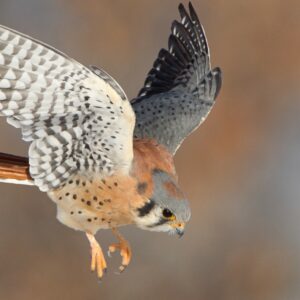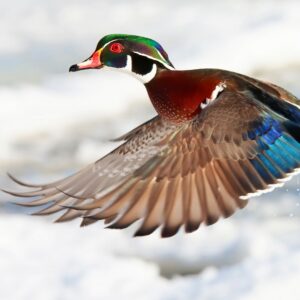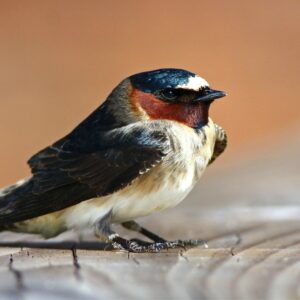Introducing Ursus maritimus
The polar bear is one of the world’s most recognizable species and one that most people would love to see in the wild.
Thank you to Andrew E. Derocher, Professor, Department of Biological Sciences at the University of Alberta, for this blog.

Inuktitut – nanuq / nanuk; Cree – wapusk / wabusk (Photo: Andrew E. Derocher)
The maritime or sea bear, also known in other languages as the ice or white bear, is the largest member of the bear family but also the one that lives the most remote from most humans. Some grizzly bears in coastal areas (where they feed on salmon) get close to the size of polar bears, but on average, polar bears win the size competition, even though the two species are very closely related. Polar bears are highly sexually dimorphic and adult males can easily weigh 500 kg and sometimes reach up to 800 kg if they are extremely fat. Females are about half the weight and show large fluctuations in their annual cycle of boom and bust ranging from as low as 100 kg to over 400 kg. The upper end of weights is restricted to pregnant females that have amassed huge fat reserves to undergo hibernation on land while gestating and then nursing cubs from a tiny 600 grams at birth to about 10 kg by the time they head onto the sea ice.
The range of polar bears is circumpolar in areas where the sea ice persists for enough of the year. The bears are distributed over a huge latitudinal range from the southern end of James Bay, which puts them about the same latitude as London in the United Kingdom, all the way to the geographic North Pole. The density of bears out on the sea ice varies from about 0.5 bears per 1000 square kilometers all the way up to over 9 bears per 1000 square kilometers across the 19 recognized populations. The density of the bears is much higher close to land and over continental shelf areas, where the marine productivity is higher and seals, the main prey of polar bears, are more common.

Adult males spend a lot of time play-fighting during the ice-free period. The ritualized play likely helps the bears develop skills that will be useful during real conflicts over mates that occur during the breeding season. (Photo: Andrew E. Derocher)
Polar bears are a long-lived species with slow population growth rates. Females can live up to 30 years old in rare cases and appear capable of having cubs throughout their lives. Older females show signs of declining condition once they are over 20 years of age, and their peak reproductive years are in their mid-teens. Similarly, the peak years of mating success for males is in their mid-teens, but once they get close to 20 years old, they show signs of wear and tear from fights associated with breeding activity. Very few males make it to their mid-20s.
The reproductive cycle of polar bears is typical of the bear family. Mating occurs in the spring, and once the egg or eggs are fertilized and are composed of only a few cells (a blastocyst), they undergo a suspended state until they implant in the autumn when the female moves into a den. (Dens are on land in most of their range, but some bears will den on the sea ice off Alaska). Sometime before the New Year, cubs are born in a very underdeveloped state. It is thought the cubs are born so small due to the physiological challenges of gestation while the mother is fasting, and that it is easier for the mother to deal with the wastes of offspring by giving birth and transferring fat rich milk (up to 40% fat) to the cubs. The average litter size for polar bears is about 2 cubs, but litters of 1 are common. Triplets occur quite often but usually are more like two and half cubs, as one is often a runt.
Cubs stay with their mothers for up to two and a half years and will nurse over that whole time. During the long association with their mother, cubs learn how to hunt seals and navigate the migration paths between the sea ice and summering areas. Polar bears show very high fidelity to the area where they are born, despite having huge roaming areas of several hundred thousand square kilometers each year (easily 100x larger than their grizzly bear relative).
The Maximum Carnivore
Polar bears are by far the most carnivorous of the bears and rely on the extremely abundant ringed seal (the “small meal deal” up to 70 kg) and the less common but larger bearded seal (can exceed 400 kg, the “big meal deal”). Most of the feeding occurs in the spring when the seals are pupping, mating, and moulting – all of which make them more vulnerable to the bears.
Technically, carnivore means “meat eater” but in reality, polar bears are much more a “fat eater.” It doesn’t take a lot of seals to sustain a polar bear, but consider that a 500 kg male polar bear that kills a 400 kg bearded seal could eat up to 20% of its weight in a single meal (100 kg). Of that ingested fat, over 90 kg of it will be deposited into the bear’s own fat cells almost unmodified. Given that the bears burn about 1 kg of body stores per day that they aren’t feeding, getting fat is important, as the ice-free period can exceed 150 days, necessitating at least 150 kg of weight just to survive.

Two young adult males assessing each other as potential playmates. The bears usually select a partner of similar size. (Photo: Andrew E. Derocher)
Future Outlook
Polar bears are perhaps the one species that people would name as being threatened by climate change—and rightly so. For polar bears, the rapid warming of the Arctic is melting their sea ice home earlier in the spring and delaying freeze-up in the autumn. While the bears are superbly adapted to going long periods without food, there are limits. If the Arctic keeps warming, many populations are predicted to disappear.
Globally, we don’t have a good estimate of polar bear abundance, as many of the populations have never been counted. Nonetheless, scientists believe a number around 25,000 is likely close. The populations in western and southern Hudson Bay have declined in abundance as has the population in the southern Beaufort Sea. Other populations, however, are not showing major signs of change largely because the sea ice hasn’t changed a lot. The best predictions indicate that the High Arctic and northern Greenland should be a climate refuge for polar bears out to the end of the century, but the future of the species will be determined by global warming and actions to control greenhouse gas emissions. Beyond climate change, polar bears are also affected by very high levels of pollution from human activities. Many pollutants bond to fat and magnify in food chains. The high fat diet of the bears and their position at the top of the food chain result in pollution levels that can interfere with body function, growth, and behaviour. Fortunately, some of the worst pollutants are now under control and their levels in polar bears have dropped or stabilized. Polar bears are hunted by local people in much of their range, but the hunting is usually managed under a quota system and is not a major threat to the bears except in a few areas.
Want to help Canadian species like the Evening Grosbeak and more? Stay tuned with the latest in Canadian nature by subscribing for email updates. You’ll receive regular updates about what we’re doing to protect Canadian nature and how you can help.



